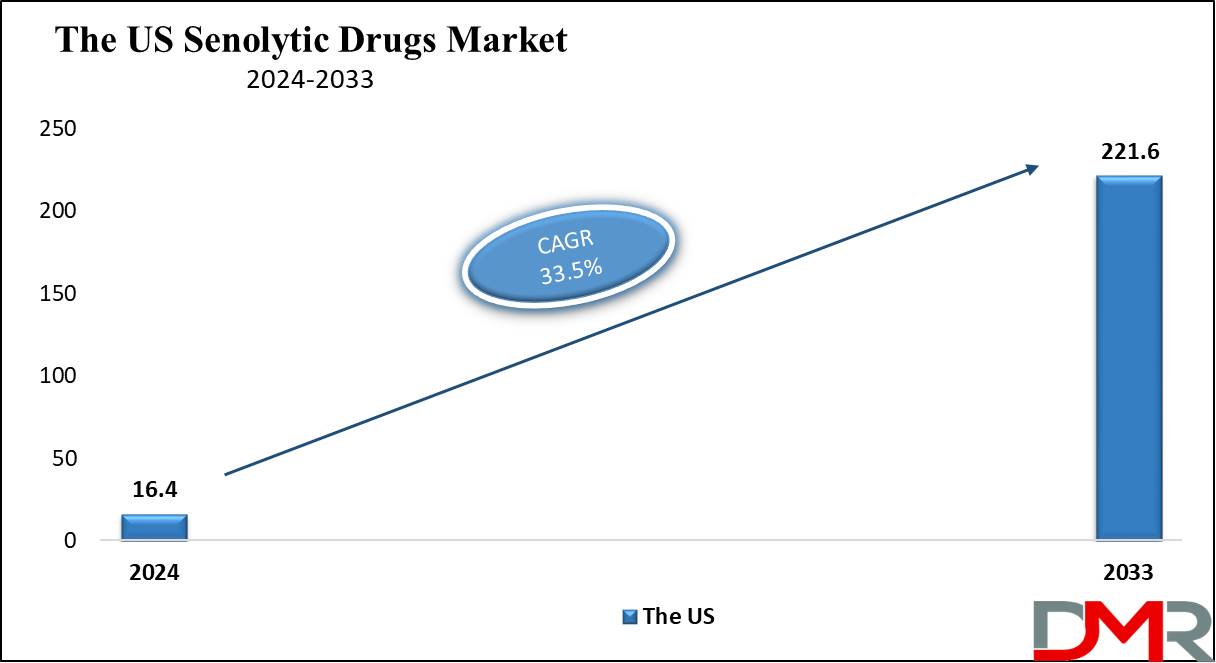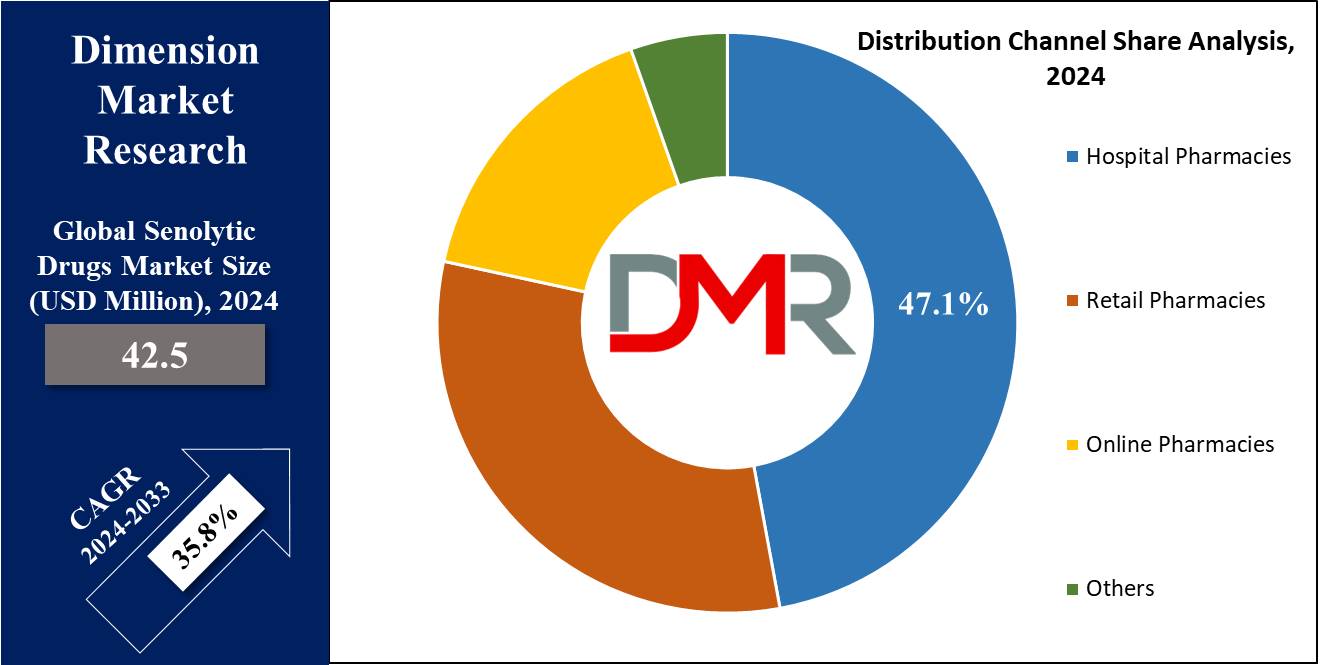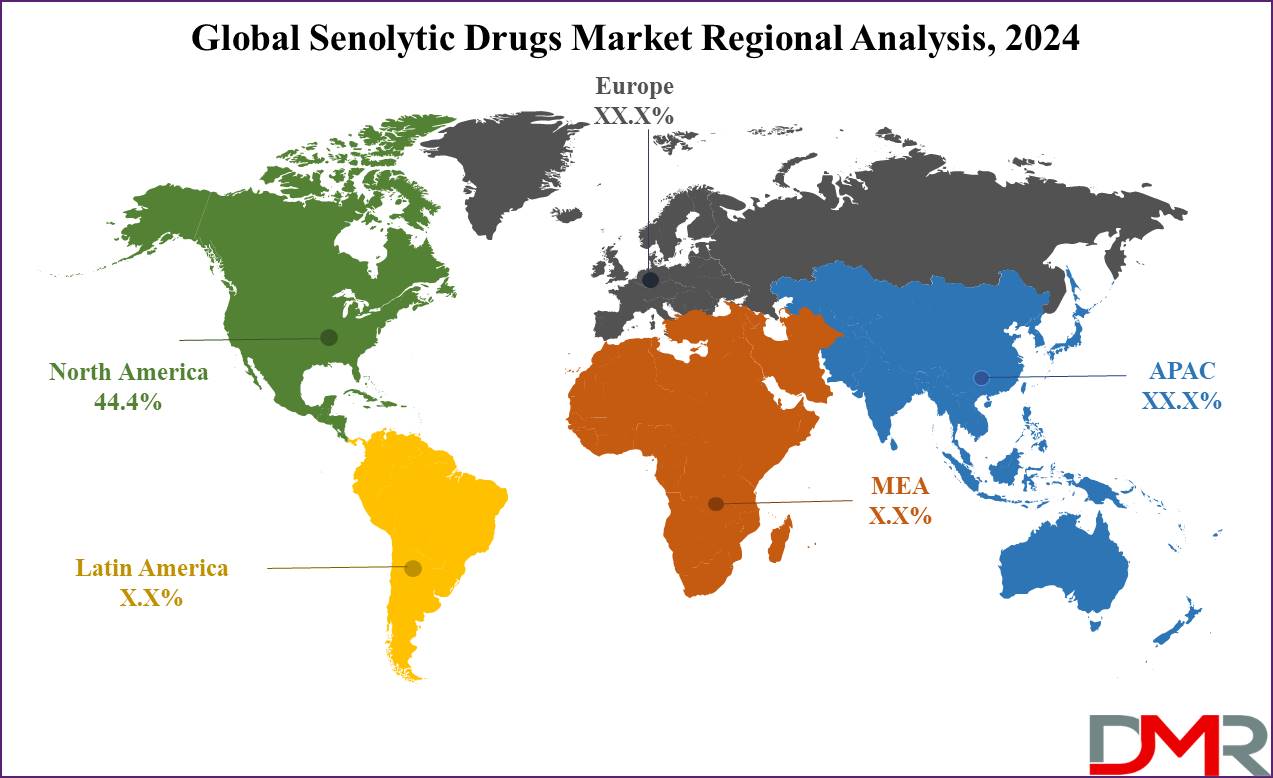Market Overview
The Global Senolytic Drugs Market is projected to reach USD 42.5 million in 2024 and grow at a compound annual growth rate of 35.8% from there until 2033 to reach a value of USD 667.6 million.
Senolytic drugs are a new type of medication developed to target and remove senescent cells, which are old & damaged cells that accumulate in our bodies as we age. These cells can create inflammation and contribute to many age-related diseases. By removing them, senolytic drugs look to improve health, minimize the risk of chronic illnesses, and potentially extend our lifespan, helping people feel better as they grow older.
As global population projections show an increase from 10% in 2022 to 16% by 2050, it has never been more crucial to develop innovative healthcare solutions like senolytic drugs. Senolytic drugs specifically target senescent cells damaged cells that accumulate with age and lead to chronic inflammation and age related diseases like cardiovascular conditions, osteoarthritis and neurodegenerative disorders by targeting and eliminating them through selective cell removal; their goal is to enhance overall health and extend lifespan.
As life expectancies continue to increase despite setbacks caused by COVID 19 pandemic, so too does demand for treatments addressing age related health concerns. Women outnumber men at older ages due to higher life expectancies; thus highlighting senolytics' importance in improving quality of life for older individuals.
Global life expectancy disparities offer an opportunity for senolytic therapies, particularly in least developed countries where life expectancies lag far behind the global average. Furthermore, the expected shift in population dynamics, with seniors projected to outnumber children under 12 by 2050 underlines their importance in promoting healthy aging and decreasing healthcare burden.
The US Senolytic Drugs Market
The
US Senolytic Drugs Market is projected to reach
USD 16.4 million in 2024 at a compound annual
growth rate of 33.5% over its forecast period.

The senolytic drugs market in the US has growth opportunities through an aging population, a growing occurrence of age-related diseases, and development in
biotechnology. Expanding research funding & collaboration between academic institutions and biotech firms can expand drug development. In addition, a focus on personalized medicine & combination therapies enhances treatment options, further driving demand and market potential.
Moreover, a key growth driver is the rising elderly population, creating a higher demand for therapies targeting age-related diseases. However, a major challenge is the limited clinical data supporting the efficacy and safety of senolytic drugs, which may impact the regulatory approvals and slow market adoption, affecting investor confidence and funding.
Key Takeaways
- Market Growth: The Senolytic Drugs Market size is expected to grow by 611.5 million, at a CAGR of 35.8% during the forecasted period of 2025 to 2033.
- By Type: The Natural Senolytics segment is anticipated to get the majority share of Senolytic Drugs Market in 2024.
- By Age Group: The geriatric age group segment is expected to be leading the market in 2024
- By Distribution Channel: The hospital pharmacies segment is expected to get the largest revenue share in 2024 in the Senolytic Drugs Market.
- Regional Insight: North America is expected to hold a 44.4% share of revenue in the Global Senolytic Drugs Market in 2024.
- Use Cases: Some of the use cases of Senolytic Drugs include cancer therapy, aging & longevity, and more.
Use Cases
- Aging and Longevity: Senolytic drugs can potentially extend a healthy lifespan by clearing senescent cells that drive age-related dysfunctions, which like enhancement in physical health, cognitive function, and overall vitality in older individuals.
- Cardiovascular Health: Senolytic drugs may be utilized to treat age-related cardiovascular diseases like atherosclerosis and hypertension by reducing inflammation and vascular stiffening caused by senescent cells in blood vessels.
- Chronic Inflammatory Diseases: Conditions like osteoarthritis, chronic obstructive pulmonary disease (COPD), and idiopathic pulmonary fibrosis (IPF) are caused by senescent cells. Senolytics can support and manage these diseases by targeting the inflammation and tissue degeneration they cause.
- Cancer Therapy: Senolytics may be beneficial in cancer treatment by removing therapy-induced senescent cells that contribute to cancer recurrence and resistance. They could enhance outcomes and reduce the side effects of chemotherapy and radiation.
Market Dynamic
Driving Factors
Rising Geriatric Population and Age-Related Diseases
The increase in the aging population across the globe is driving the need for therapies that can address age-related health issues. As people live longer, the incidence of chronic conditions like cardiovascular diseases, osteoarthritis, and neurodegenerative disorders also grows'. Senolytic drugs, with their ability to target senescent cells, provide a promising solution to enhance healthspan and manage these conditions, fueling market growth.
Advancements in Biotechnology and Drug Development
Quick progress in biotechnology, genomics, and drug discovery techniques has enhanced the identification and development of senolytic compounds. Increased research &
clinical trials in the field, assisted by funding from both public and private sectors, are developing innovative drug formulations, which is driving market expansion as senolytics move closer to regulatory approval and commercial availability.
Restraints
Limited Clinical Data and Regulatory Challenges
Even after promising preclinical results, there is very little clinical evidence supporting the safety and efficacy of senolytic drugs in humans. Regulatory approval may be slow due to the unfamiliarity of these therapies and the requirement for long-term studies.
High Development Costs and Investment Risks
The high costs linked with research, development, and clinical trials for senolytic drugs create financial risks for pharmaceutical companies. Investors may wait due to uncertainties surrounding the commercial viability and therapeutic outcomes of these treatments.
Opportunities
Expanding Applications in Age-Related Diseases
Senolytic drugs have the potential to target a variety of age-related conditions, from cardiovascular diseases to neurodegenerative disorders. As research discovers new therapeutic areas, the market can expand into untapped medical fields, growing its demand.
Collaborations and Partnerships
Numerous collaborations between academic institutions, biotech companies, and pharmaceutical giants can expand the development and commercialization of senolytic drugs, as strategic partnerships could lower costs, share risks, and improve innovation, providing opportunities for rapid market growth.
Trends
Shift Towards Combination Therapies
There is a major interest in combining senolytic drugs with other treatments, like anti-inflammatory agents or cancer therapies, to improve efficacy, which aims to use the synergistic effects of targeting multiple aging pathways, enhancing the overall therapeutic outcomes.
Increased Focus on Personalized Medicine
Development in genomics and biomarkers are allowing more personalized approaches to senolytic therapies. Customizing treatments based on an individual's specific aging profile or disease state is becoming a key focus, allowing for more effective and targeted interventions.
Research Scope and Analysis
By Type
Natural senolytics, compounds derived from plants and other natural sources, play a major role in the growth of the senolytic drugs market and are expected to lead the market in 2024, as they target and remove senescent cells, which are aging cells that can contribute to many age-related diseases. As researchers discover the potential health benefits of natural senolytics, promoting longevity and enhancing overall health, there is a major interest in developing these products for therapeutic use.
The higher awareness of aging and its impact on health has led to a growth in demand for effective treatments that can help reduce the effects of aging. Natural senolytics provide a good alternative to synthetic drugs, often boasting fewer side effects and more holistic benefits. This aligns with major trends in healthcare, where patients and providers alike are looking for safer, more natural treatment options. Additionally, the rise of
digital health solutions supports this shift by enabling better monitoring, personalized wellness plans, and easier access to aging-related treatments.
Further, the exploration & commercialization of natural senolytics are anticipated to drive significant growth in the senolytic drugs market, attracting both investors and consumers interested in age-related therapies.
By Therapeutic Application
Cardiovascular disease (CVD) is becoming a vital therapeutic application in the growth of the senolytic drugs market and is anticipated to lead throughout the forecast periods, as senolytics are developed to eliminate senescent cells, which rack up with age and contribute to many health problems, like heart disease. Research has shown that these aging cells can increase inflammation and other risk factors linked with CVD.
By targeting and eliminating these cells, senolytic drugs may assist in enhancing heart health and reducing the risk of cardiovascular events. As the global population ages, the occurrence of cardiovascular diseases is mostly increasing, leading to a large requirement for effective treatments, which develops a major opportunity for senolytic drugs, that could provide new ways to manage & potentially reverse some of the damage caused by aging in cardiovascular health.
By Age Group
In terms of age group, the market is categorized into geriatric, middle-aged, and others, among which the geriatric age group is set to play a crucial role in the growth of the senolytic drugs market by leading the market in 2024.
As people age, they face many health issues linked to the accumulation of senescent cells, which can develop chronic diseases and a decline in complete well-being. Senolytic drugs are developed to target and eliminate these aging cells, providing the potential for healthier aging and better quality of life.
With the global population of older adults steadily increasing, there is an increase in the demand for effective treatments that can address age-related conditions, which is driving interest and investment in such therapies, as researchers and companies focus on developing solutions customized to the distinctive needs of geriatric patients.
In addition, healthcare providers are becoming more aware of the benefits of senolytics, leading to large acceptance and usage in geriatric care.
By Mode of Administration
Oral drugs are projected to have the majority of the revenue share of the senolytic drugs market in 2024 due to their convenience & ease of use. Administering medication in pill or capsule form is generally more acceptable to patients, mainly older adults, who may have difficulty with injections or other methods, as it allows for better adherence to treatment regimens, as patients find it easier to use oral drugs into their daily routines.
Further, research into senolytic drugs is aims at developing formulations that ensure effective absorption & bioavailability when taken orally. As awareness of the benefits of senolytic therapies grows, the need for user-friendly options is likely to groq.
Furthermore, pharmaceutical companies are investing in innovations that improve the stability and effectiveness of oral senolytics, making them more appealing to both healthcare providers and patients, which is anticipated to significantly contribute to the expansion of the senolytic drugs market, as it aligns with the preferences of patients looking into effective age-related treatments.
By Distribution Channel
Hospital pharmacies play a vital role as a distribution channel in driving the growth of the senolytic drugs market and are expected to do so throughout the forecast period. These pharmacies act as an important link between drug manufacturers and patients, making sure that innovative therapies are readily available in healthcare settings. As awareness of senolytic drugs grows, hospital pharmacies are distinctively positioned to give access to these treatments, mainly for patients dealing with age-related conditions.

By stocking senolytic drugs, hospital pharmacies can provide timely treatment for patients who may benefit from these therapies, enhancing complete patient care. In addition, pharmacists in hospital settings are knowledgeable about the latest research and can help in educating healthcare providers about the benefits and appropriate use of senolytic drugs, which can lead to more informed prescribing practices and large patient acceptance.
As the demand for effective age-related treatments grows, hospital pharmacies are likely play an important role in the distribution and management of senolytic therapies, contributing to the overall expansion of this emerging market.
The Senolytic Drugs Market Report is segmented on the basis of the following
By Type
- Natural Senolytics
- Quercetin
- Fisetin
- Curcumin
- Synthetic Senolytics
- Navitoclax
- Dasatinib
- FOXO4-DRI
- UBX0101 (Unity Biotech)
- Others
By Therapeutic Application
- Cardiovascular Diseases
- Neurological Disorders
- Osteoarthritis
- Cancer
- Diabetes
- Others
By Age Group
- Geriatric
- Middle-Aged
- Others
By Mode of Administration
- Oral Drugs
- Injectable Senolytics
- Topical Application
- Others
By Distribution Channel
- Hospital Pharmacies
- Retail Pharmacies
- Online Pharmacies
- Others
Regional Analysis
North America is anticipated to lead the senolytic drugs market in 2024
with a share of 44.4% due to its advanced healthcare infrastructure and strong focus on research and development. The region is home to numerous leading pharmaceutical companies and research institutions that are constantly exploring the potential of senolytic therapies. High awareness of aging-related health issues among the population has driven demand for innovative treatments.

In addition, supportive regulatory frameworks and investment in biotech innovations further improve region’s position as a key player in the senolytic drugs market, promoting growth and development in this area. Further, the Asia Pacific region is emerging as the fastest growing region in the senolytic drugs market, driven by a large aging population and growth in healthcare needs.
Countries like China & India are experiencing growing awareness of age-related health issues, creating a demand for effective treatments. In addition, large investments in research and development, along with growing biotech sectors, are promoting innovation in senolytic therapies in the region.
By Region
North America
Europe
- Germany
- The U.K.
- France
- Italy
- Russia
- Spain
- Benelux
- Nordic
- Rest of Europe
Asia-Pacific
- China
- Japan
- South Korea
- India
- ANZ
- ASEAN
- Rest of Asia-Pacific
Latin America
- Brazil
- Mexico
- Argentina
- Colombia
- Rest of Latin America
Middle East & Africa
- Saudi Arabia
- UAE
- South Africa
- Israel
- Egypt
- Rest of MEA
Competitive Landscape
The senolytic drugs market is quite new and competitive, with various biotechnology firms and research institutions aiming to develop innovative therapies. The market is still in its early stages, characterized by high research, clinical trials, and growth in collaboration between academic and commercial entities. Companies are largely exploring senolytic compounds targeting a variety of age-related diseases, aiming for first-mover advantages.
As clinical evidence grows, the competition is expected to intensify, with the potential for breakthroughs in personalized treatments & combination therapies, creating faster commercialization and market expansion.
Some of the prominent players in the Global Senolytic Drugs are
- Unity Biotechnology
- Cleara Biotech
- Gero LLC
- Novartis AG
- Sierra Oncology
- Senolytic Therapeutics Inc
- Vera Therapeutics
- FoXBio Inc
- Numeric Biotech
- Agex Therapeutics
- Other Key Players
Recent Developments
- In July 2024, Immorta Bio Inc. unveiled the filing of an Investigational New Drug (IND) application with the FDA, which is to initiate a clinical trial to evaluate the safety, immunogenicity, and efficacy signals of SenoVax in patients with advanced non-small cell lung cancer. The trial will recruit patients who have failed normal therapies and will comprise 3 patient groups getting high doses of SenoVax.
- In February 2024, Cepham unveiled the expansion of its Sustainable Aging product line to include senolytics, focused on redefining approaches to healthy aging. Senescent cells are also called "zombie cells" among scientists, owing to their lingering presence in the body, which can create detrimental effects on surrounding healthy cells. The accumulation of senescent cells over time may contribute to various age-related diseases and a decline in overall health.
- In January 2024, Researchers from the State University of Campinas and Pontifical Catholic University of Campinas in Brazil published a new study reporting that therapeutic targeting of senescent cells could be promising in treating chronic lung diseases associated with aging, as it has explored and tested new drug and polyphenol combinations, focused on identifying effective senolytic activity.
Report Details
|
Report Characteristics
|
| Market Size (2024) |
USD 42.5 Mn |
| Forecast Value (2033) |
USD 667.6 Mn |
| CAGR (2024-2033) |
35.8% |
| Historical Data |
2018 – 2023 |
| The US Market Size (2024) |
USD 16.4 Mn |
| Forecast Data |
2025 – 2033 |
| Base Year |
2023 |
| Estimate Year |
2024 |
| Report Coverage |
Market Revenue Estimation, Market Dynamics, Competitive Landscape, Growth Factors and etc. |
| Segments Covered |
By Type (Natural Senolytics, Synthetic Senolytics, and Others), By Therapeutic Application (Cardiovascular Diseases, Neurological Disorders, Osteoarthritis, Cancer, Diabetes, and Others), By Age Group (Geriatric, Middle-Aged, and Others), By Mode of Administration (Oral Drugs, Injectable Senolytics, Topical Application, and Others), By Distribution Channel (Hospital Pharmacies, Retail Pharmacies, Online Pharmacies, and Others) |
| Regional Coverage |
North America – The US and Canada; Europe – Germany, The UK, France, Russia, Spain, Italy, Benelux, Nordic, & Rest of Europe; Asia- Pacific– China, Japan, South Korea, India, ANZ, ASEAN, Rest of APAC; Latin America – Brazil, Mexico, Argentina, Colombia, Rest of Latin America; Middle East & Africa – Saudi Arabia, UAE, South Africa, Turkey, Egypt, Israel, & Rest of MEA |
| Prominent Players |
Unity Biotechnology, Cleara Biotech, Gero LLC, Novartis AG, Sierra Oncology, Senolytic Therapeutics Inc, Vera Therapeutics, FoXBio Inc, Numeric Biotech, Agex Therapeutics, and Other Key Players |
| Purchase Options |
We have three licenses to opt for: Single User License (Limited to 1 user), Multi-User License (Up to 5 Users) and Corporate Use License (Unlimited User) along with free report customization equivalent to 0 analyst working days, 3 analysts working days and 5 analysts working days respectively. |
Frequently Asked Questions
The Global Senolytic Drugs Market size is expected to reach a value of USD 42.5 million in 2024 and is expected to reach USD 667.6 million by the end of 2033.
North America is expected to have the largest market share in the Global Senolytic Drugs Market with a share of about 44.4% in 2024.
The Senolytic Drugs Market in the US is expected to reach USD 16.4 million in 2024.
Some of the major key players in the Global Senolytic Drugs Market are Unity Biotechnology, Cleara Biotech, Gero LLC, and others.
The market is growing at a CAGR of 35.8 percent over the forecasted period.